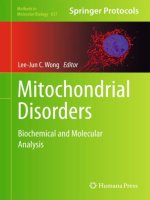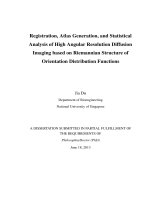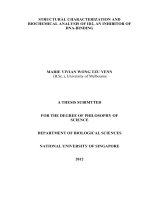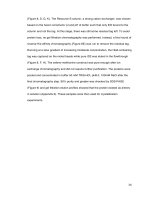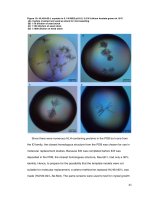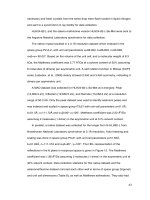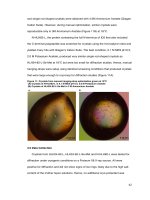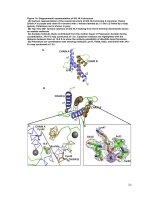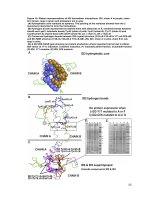LIVE TRACKING VIRE2 PROTEIN AND MOLECULAR ANALYSIS OF YEAST FACTOR PMP3P DURING AGROBACTERIUM MEDIATED TRANSFORMATION
Bạn đang xem bản rút gọn của tài liệu. Xem và tải ngay bản đầy đủ của tài liệu tại đây (3.49 MB, 147 trang )
LIVE-TRACKING VIRE2 PROTEIN AND
MOLECULAR ANALYSIS OF YEAST FACTOR
PMP3P DURING AGROBACTERIUM-MEDIATED
TRANSFORMATION
LI XIAOYANG
NATIONAL UNIVERSITY OF SINGAPORE
2013
LIVE-TRACKING VIRE2 PROTEIN AND
MOLECULAR ANALYSIS OF YEAST FACTOR
PMP3P DURING AGROBACTERIUM-MEDIATED
TRANSFORMATION
LI XIAOYANG
(B. Sc. Science.)
A THESIS SUBMITTED
FOR THE DEGREE OF DOCTOR OF
PHILOSOPHY
DEPARTMENT OF BIOLOGICAL SCIENCES
NATIONAL UNIVERSITY OF SINGAPORE
2013
I
ACKNOWLEDGEMENTS
I would like to express my sincere gratitude to my supervisor, Associate
Professor Pan Shen Quan, for his patient guidance and plenty of valuable opinions he
provided in my research studies.
I would like to thank Professor Yu Hao to give me the opportunity to pursue my
graduate studies in Department of Biological Sciences, National University of
Singapore. I also would like to thank Professor Wong Sek Man, Associate Professor
Adam Yuan, Yu-Ren and Assistant Professor Xu Jian, for their kind help and advices
during my research progress.
I would like to express my appreciation and thanks to my project collaborator, Dr.
Yang Qinghua, for his effort and help during my research works. I would also like to
thank Ms Xu Songci, Ms Tan Lu Wee and Ms Tong Yan for their technical supports.
I would also like to thank the following research fellows and laboratory members
who have helped me in different ways, Dr. Tu Haitao, Dr. Gong Ximing, Dr. Niu
Shengniao, Dr. Chu Huangwei, Chen Zikai, Wang Bingqing, Lim Zijie, Wang Yanbin,
Wen Yi, Gao Ruimin, Wang Juan, Zhang Chen, Hong Jinghan and Guo Song.
Finally, I gratefully acknowledge the financial support provided by National
University of Singapore.
II
TABLE OF CONTENTS
ACKNOWLEDGEMENTS I
TABLE OF CONTENTS II
SUMMARY VI
MANUSCRIPTS RELATED TO THIS STUDY VIII
LIST OF TABLES IX
LIST OF FIGURES X
LIST OF ABBREVIATIONS XII
Chapter 1. Literature Review 1
1.1. Agrobacterium tumefaciens as a genetic tool in biotechnology 2
1.1.1. Genetic engineering of plants in the era of functional genomics 2
1.1.2. Agrobacterium-mediated transformation of non-plant species 3
1.2. Agrobacterium-mediated transformation 3
1.2.1. Host recognition and virulence gene expression 3
1.2.2. Bacteria attachment and translocation of virulence factors 5
1.2.3. Nuclear targeting and T-DNA integration 7
1.3. Host proteins involved in AMT process 8
1.3.1. Agrobacterium attachment and virulence factors transfer 8
1.3.2. Cytoplasmic trafficking and Nucleus targeting 9
1.3.3. Chromatin targeting and T-DNA integration 10
1.4. Agrobacterium and plant immunity response 12
1.4.1. Agrobacterium perception by plant cells 12
1.4.2. Host cell transcriptional re-programming 13
1.4.3. Evading of Agrobacterium from the host defense response 13
1.5. Objectives 15
Chapter 2. Materials and Methods 16
2.1. Strains, plasmids and Culture 16
2.2. DNA manipulations 16
2.2.1. Molecular cloning 16
2.2.2. Preparation of yeast genomic DNA 16
2.2.3. Preparation of A. tumefaciens genomic DNA 25
2.2.4. Transformation of A. tumefaciens by electroporation 25
III
2.2.5. Lithium acetate transformation of yeast 26
2.3. RNA manipulations 26
2.3.1. Total RNA extraction from yeast cells. 26
2.3.2. Total RNA extraction from A. thaliana cells. 27
2.3.3. Real time RT-PCR analysis 27
2.4. Protein analytical Techniques 27
2.4.1. SDS-PAGE gel electrophoresis 27
2.4.2. Western blot analysis 30
2.5. Agrobacterium-mediated transformation of yeast 30
2.6. Tumorigenesis 31
2.6.1. Tumorigenesis of Kalanchoe daigremontiana 31
2.6.2. Root transformation assay of Arabidopsis thaliana 31
2.7. Agroinfiltration 32
Chapter 3. Live tracking of Agrobacterium VirE2 protein in host cells 33
3.1. Introduction 33
3.2. General study of Agrobacterium VirE2 in AMT process 36
3.2.1. Generation of VirE2 deletion mutants in Agrobacterium strains 36
3.2.2. Agrobacterium VirE2 is indispensable in transformation of plants 39
3.2.3. Agrobacterium VirE2 is important in AMT of yeast 40
3.3. Development of Split-GFP detection system in yeast cells 41
3.3.1. General strategy of Split-GFP system for protein detection 41
3.3.2. Development of Split-GFP system in yeast cells 43
3.4. Localization of Agrobacterium VirE2 protein in yeast cells 46
3.4.1. General strategy of Agrobacterium VirE2 protein labeling 46
3.4.2. Labeling of Agrobacterium VirE2 protein with GFP11 47
3.4.3. Localization of Agrobacterium VirE2 protein in yeast cells 50
3.5. Study of Agrobacterium-delivered VirE2 in yeast cells 51
3.5.1. Construction of Agrobacterium VirE2 labeling mutants 53
3.5.2. Virulence assay of Agrobacterium VirE2 labeling mutants 53
3.5.3. Detection of Agrobacterium VirE2 during natural AMT process 55
3.6. Study of Agrobacterium delivered VirE2 during AMT process 59
3.6.1. The bacteria growth and VirE2 expression level is not significantly
perturbed by the GFP11 tag 59
3.6.2. General study of Agrobacterium delivered VirE2 in yeast cells 62
3.6.3. Study of VIP1 in yeast cells 64
3.6.4. Quantitative study of VirE2 delivery in AMT of yeast 66
IV
3.6.5. Preliminary study of VirE2 degradation in yeast cells. 68
3.7. VirE2 behavior study in plant cells 69
3.7.1. Establishing Split-GFP system in plant cells 69
3.7.2. Study of nuclear localization signals in VirE2 72
3.8. Discussion 76
Chapter 4. Study of host Pmp3p in Agrobacterium-mediated transformation of
yeast 81
4.1. Introduction 81
4.2. A host Pmp3p affected Agrobacterium-mediated transformation in yeast 81
4.2.1. A yeast mutant pmp3∆ is more resistant to Agrobacterium-mediated
transformation 81
4.2.2. Yeast Pmp3p is a membrane protein related to cellular ion homeostasis 82
4.2.3. Resistance of pmp3∆ to Agrobacterium-mediated transformation displays a
temperature dependent pattern 86
4.3. The VirD2 nucleus targeting process is not affected in yeast mutant pmp3∆ 88
4.4. Yeast mutant pmp3∆ showed an decreased competency to
Agrobacterium-mediated delivery of VirE2 91
4.5. Discussion 93
Chapter 5. Study of RCI2 family proteins in plant immunity responses 96
5.1. Introduction 96
5.2. PMP3 protein family 97
5.2.1. PMP3 protein family in lower forms of eukaryotes and higher plants 97
5.2.2. PMP3 family proteins in Arabidopsis thaliana 99
5.3. Arabidopsis rci2a mutant showed resistance to AMT 101
5.4. Arabidopsis RCI2 family shows down regulated expression under biotic stress
103
5.4.1. Arabidopsis RCI2 family showed down regulated expression pattern upon
Agrobacterium infection 103
5.4.2. Arabidopsis RCI2 family showed down regulated expression pattern upon
treatment with pathogen-associated molecular patterns 105
5.5. Discussion 107
Chapter 6. Conclusions and future prospects 110
6.1. Conclusions 110
V
6.2. Future prospects 111
Bibliography 112
VI
SUMMARY
As a natural genetic engineer, Agrobacterium tumefaciens is capable of
transferring single-stranded DNA molecule (T-DNA) into various recipients.
Infection of this bacterium is greatly facilitated by the translocated virulence protein
VirE2, which is involved in the entire transformation process inside recipient cells
including T-DNA uptake, nucleus import and chromatin integration. However,
previous studies of VirE2 lead to conflicting results due to lack of appropriate tagging
approaches. In this study, a bipartite split-GFP system was adopted to track the
Agrobacterium delivered VirE2 inside recipient cells. Using the split-GFP strategy,
the VirE2 was visualized for the first time inside host cells after the delivery. This
Split-GFP tagging system does not affect VirE2 function, and thus is suitable for
VirE2 behavior study in vivo. Relatively high VirE2 delivery efficiency has been
observed in non-natural host yeast, highlighting the Agrobacterium as an excellent
protein transporter. Besides, filamentous structures of VirE2 in the absence of T-DNA
have also been observed in vivo for the first time. Bacteria-delivered VirE2 was
actively transported into plant nucleus in a nuclear localization signal
(NLS)-dependent manner, while it stayed exclusively inside yeast cytoplasm and no
clear movement could be observed. This study helps to further understand the
mechanism of VirE2 trafficking inside host cells and also enabled other in vivo
studies of Agrobacterium virulence proteins in the future.
Previous studies of Agrobacterium-mediated transformation (AMT) mainly
focused on the transformation process inside the bacteria; however, little is known
about the host factors that also play important roles. Using yeast as the model, the role
of a host membrane protein Pmp3p in AMT process has been identified. Deletion of
this protein resulted in decreased efficiencies of virulence protein delivery as well as
the transformation, suggesting a role of this membrane protein in bacterial attachment
and virulence factor translocation.
VII
Subsequent studies of yeast PMP3 family revealed the potential role of RCI2
family proteins in Arabidopsis immunity responses. Active down regulation of these
genes was observed upon either Agrobacterium infection or flg22 treatment,
indicating that these genes might be involved in plant immunity system through
interaction with the plasma membrane ion channels. The results from this study help
to further understand the host factors in AMT process and also shed light on the
complex signaling network of plants in response to both biotic and abiotic stresses.
VIII
MANUSCRIPTS RELATED TO THIS STUDY
Li, X.
†
, Yang, Q.
†
, Tu, H. Lim Z and Pan, S. Q. (2013). Direct visualization of
Agrobacterium-delivered VirE2 in recipient cells The Plant Journal 2013 Dec 2. doi:
10.1111/tpj.12397
†
Equal contribution
Li, X., Yang, Q., Tu, H. and Pan, S. Q. (2014). A yeast membrane protein Pmp3p is
involved in Agrobacterium-mediated transformation. Manuscript in preparation.
IX
LIST OF TABLES
Table 2.1. Yeast and bacterial strains used in this study 17
Table 2.2. Plasmids used in this study 19
Table 2.3. Media and solutions used in this study 24
Table 2.4. Primers used for real-time PCR in this study 28
Table 2.5. Buffers and solutions used in SDS-PAGE gel electrophoresis 29
Table 3.1. Comparison of transient transformation, stable transformation and
VirE2 delivery in AMT of yeast. 67
X
LIST OF FIGURES
Figure 3.1. Possible roles of VirE2 in Agrobacterium-mediated transformation. 34
Figure 3.2. Schematic diagram of virE2 deletion strategy. 38
Figure 3.3. Virulence study of Agrobacterium virE2 mutant in plant. 39
Figure 3.4. Virulence study of Agrobacterium virE2 deletion mutant in yeast. 40
Figure 3.5. Schematic diagram of Split-GFP system. 42
Figure 3.6. Schematic diagram of Split-GFP system testing is yeast cells. 43
Figure 3.7. Development of Split-GFP system in yeast cells. 45
Figure 3.8. Schematic diagram of Agrobacterium VirE2 labeling strategy. 46
Figure 3.9. Schematic diagram of transgenic expression of VirE2 in yeast. 48
Figure 3.10. Schematic diagram of internal labeling of VirE2. 49
Figure 3.11. Localization of GFP11 labeled VirE2 in yeast cells. 51
Figure 3.12. Schematic diagram of Agrobacterium-delivered VirE2 detection. 52
Figure 3.13. Virulence assay of GFP11 labeled Agrobacterium VirE2 mutants in
yeast. 54
Figure 3.14. Detection of Agrobacterium delivered VirE2 in yeast cells. 56
Figure 3.15. GFP fluorescence is not detected in yeast when omiting any
Split-GFP component or deletion of virD4. 57
Figure 3.16. Full length GFP labeled VirE2 failed to be delivered by
Agrobacterium. 58
Figure 3.17. The Split-GFP system does not significantly affect bacterial growth
and virulence protein expression. 60
Figure 3.18. General study of Agrobacterium delivered VirE2 in yeast cells. 63
Figure 3.19. Study of VIP1 in VirE2 nucleus targeting process in yeast cells. 65
Figure 3.20. Transient transformation assay in yeast. 67
Figure 3.21. Degradation assay of VirE2 in yeast cells. 68
Figure 3.22. GFP11 does not perturb the function of VirE2 in AMT of plants. 71
Figure 3.23. Study of putative nuclear localization signals of VirE2 in AMT of N.
benthamiana epidermal cells. 74
Figure 3.24. GFP fluorescence is not detected in N. benthamiana epidermal cells
when omiting any split-GFP component or deletion of virD4 75
Figure 4.1. A yeast mutant pmp3∆ showed decreased transformation efficiency in
AMT. 82
Figure 4.2. Plasma membrane localization of Pmp3p in yeast cells. 84
Figure 4.3. Pmp3p is required for cellular ion homeostasis. 85
Figure 4.4. Comparison of lithium acetate transformation efficiency between
pmp3∆ and wild type BY4741. 87
Figure 4.5. Yeast mutant pmp3∆ is resistant to AMT in a temperature dependent
pattern. 87
Figure 4.6. VirD2 nucleus targeting process is not affected in yeast mutant
XI
pmp3∆. 90
Figure 4.7. VirE2 translocation is affected in yeast mutant pmp3∆ during AMT
process 92
Figure 5.1. Sequence comparison of PMP3 family proteins. 98
Figure 5.2. Sequence comparison of RCI2 family proteins in A. thaliana. 99
Figure 5.3. Expression patterns of PMP3 family in response to cold treatment.
100
Figure 5.4. Arabidopsis rci2a mutant showed resistance to AMT. 102
Figure 5.5. Down regulated expression pattern of RCI2 family in Arabidopsis
leaves and roots upon Agrobacterium infection. 104
Figure 5.6. Down regulated expression pattern of RCI2 family in Arabidopsis
leaves could be induced by PAMPs. 106
XII
LIST OF ABBREVIATIONS
ABA
abscisic acid
ml
milliliter(s)
Amp
ampicillin
mM
millimole(s)
AMT Agrobacterium-mediated
transformation
MS Murashige & Skoog
AS
acetosyringone
NHEJ
non-homologous
end-joining
ATP
adenosine triphosphate
NHR
non-homologous
recombination
bp
base pair(s)
NLS
nuclear localization
signal
CM
co-cultivation medium
PAMP
pathogen-associated
molecular pattern
CRAfT Cre Recombinase Assay for
Translocation
PBS Phosphate Buffered
Saline
DAPI
4',6-diamidino-2-phenylindole
PCR
polymerase chain
reaction
DNA
deoxyribonucleic acid
PEG
polyethylene glycol
EF-Tu
elongation factor Tu
PTI
PAMP-triggered
immunity
g
gram(s) RT-PCR reverse transcription
polymerase chain
reaction
GUS β-D-glucuronidase
SDS sodium dodecyl sulfate
Km
kanamycin
SDS-PAGE
sodium dodecyl sulfate
polyacrylamide gel
electrophoresis
LB
Luria-Bertani
T4SS
type IV secretion system
LiAc
lithium-acetate
T-DNA
transfer DNA
LRR leucine rich repeat Ti tumor-inducing
M
mole(s)
μg
microgram(s)
MAPK
mitogen-activated protein
kinase
μl
microliter(s)
mg
milligram(s)
1
Chapter 1. Literature Review
Agrobacterium tumefaciens, as one of the most commonly studied
Agrobacterium species, is a soil borne phytopathogen that causes tumor-like growth
or gall at the wound parts of host plants during infection. The molecular basis is
related to the (~200 kb) tumor-inducing (Ti) plasmid of the bacteria (Hooykaas et al.
1992). During infection process, the bacteria can transfer a part of the Ti plasmid
(T-DNA) into plant cells, which subsequently enters host nucleus and integrated into
the host genome through non-homologous recombination (NHR) (Offringa et al.
1990). The integrated T-DNA is responsible for uncontrolled plant cell proliferation
by producing enzymes that catalyze the synthesis of plant hormone such as auxin and
cytokinin. The transferred T-DNA can also synthesize several kinds of amino
acid–sugar conjugates named opines, which could be uniquely used as the carbon and
nitrogen resources and thus could provide selective advantages for the pathogen
(Dessaux et al. 1988).
A. tumafaciens is able to transfer any DNA sequence within the T-DNA region
into host cells; thus various efforts have been made to introduce genes of interest into
T-DNA region for intended genetic manipulations (Garfinkel et al. 1981; Zambryski
et al. 1983; Fraley et al. 1985). However, plenty of difficulties had emerged
concerning the relatively large size of the Ti plasmid, which makes it hard to be
manipulated in molecular cloning works, such as difficulty in isolation, lack of unique
restriction endonuclease sites, low copy number as well as containing oncogenes. To
address this, binary vector systems were developed in 1983 to separate the T-DNA
region apart from the Ti plasmid onto a new vector (Deframond et al. 1983; Hoekema
et al. 1983). The bacterium with its original T-DNA region deleted was regarded as a
vir helper strain; the helper strain could recognize and deliver the T-DNA region as
long as the T-DNA harboring vector was introduced into the same bacterial cell. The
separated binary vector has greatly simplified the genetic manipulation process and
2
also makes it practical to use multiple copies of T-DNA with different features at the
same time. With the binary vector systems, the utility of Agrobacterium-mediated
transformation (AMT) in plant researches become wide and diverse.
In this section, a brief review will be included concerning the usage of
Agrobacterium in biotechnology, process of AMT, host factors involved in AMT
process, as well as the Agrobacterium-induced plant immunity.
1.1. Agrobacterium tumefaciens as a genetic tool in biotechnology
1.1.1. Genetic engineering of plants in the era of functional genomics
The natural host range of A. tumefaciens spans most of the plant family in the
plant kingdom. Early studies in 1970s showed that up to 56% of the gymnosperms
and 58% of the angiosperms were able to be transformed by wild type Agrobacterium
strains (Decleene et al. 1976; Decleene et al. 1981). Moreover, by using combination
of different Agrobacterium strains and inoculation approaches, some recalcitrant
plants also displayed susceptibility to AMT under laboratory conditions (Ishida et al.
1996; Hiei et al. 1997; Chen et al. 2006); and the number of plant species reported to
be transformed by Agrobacterium is still increasing. The extremely wide host range of
A. tumefaciens greatly increases its application in plant genetic manipulations.
With the advancing technology in the field of biological sciences, we have
entered the era of functional genomics and more and more genome sequences of
various plant species become available. Meanwhile, the need of different tools in
large-scale genomic studies is increasing. Using Agrobacterium as a vector for
efficient horizontal gene transfer becomes convenient in random mutagenesis of plant
genome.
Plenty of systemic studies have been carried out by using Agrobacterium as the
insertional mutagenesis tool in plants, such as Arabidopsis thaliana, Oryza sativa, and
Nicotiana species (Koncz et al. 1989; Koncz et al. 1992; Jeon et al. 2000;
Radhamony et al. 2005). These useful works have established foundations for the
3
functional genomics studies in various research fields.
1.1.2. Agrobacterium-mediated transformation of non-plant species
Except for the natural host species in plant kingdom, the range of Agrobacterium
host has been extremely expanded under laboratory conditions.
It has been shown that more than 80 non-plant species were able to be transiently
or stably transformed by Agrobacterium, in the presence of plant wounding-related
phenolic compounds such as acetosyringone (AS), including bacteria, algae, fungi and
mammalian cells (Michielse et al. 2005; Lacroix et al. 2006). The “promiscuous”
characteristic of Agrobacterium suggest that it could also be used as genetic tools in
the study of other non-plant organisms.
Interestingly, unlike the non-homologous end joining recombination happens in
plant cells, T-DNA mainly relied on homologous recombination in chromosomal
integration of non-plant hosts such as Saccharomyces cerevisiae (Bundock et al.
1995). This enables the targeted genetic manipulation of these organisms. Moreover,
the relatively conserved transformation process in these different Agrobacterium hosts
makes it possible to using simplified and efficient system such as yeast to study the
transformation process as well.
1.2. Agrobacterium-mediated transformation
Agrobacterium-mediated transformation is a complex process which begins with
plant signal recognition and ends in the expression of T-DNA integrated in the host
genome. The transformation is a long-term evolved process which requires the
participation of both pathogen as well as various host factors. This section will mainly
focus on the bacterial factors involved in this process.
1.2.1. Host recognition and virulence gene expression
A. tumefaciens is an environmental microorganism and can live in the soil
4
independent of host plants. However, opines production after plant cell transformation
serves as a selective advantage thus provides a preferable environment for the
bacteria.
Agrobacterium-mediated transformation commonly happens at the wound sites
of the host plants, where the plant wound associated phenolic compounds such as
acetosyringone serve as the activation signals (Stachel et al. 1985). Except the host
associated compounds including phenols and aldose monosaccharides, some
environmental factors such as low pH and low PO
4
have also been shown to be
involved in virulence gene induction (Palmer et al. 2004; Brencic et al. 2005).
Perception of plant wound signals is achieved through a two-component
VirA/VirG system (Stachel et al. 1986). Although inducible as the other virulence
genes, virA and virG are constantly expressed at a basic level under normal growth
condition (Winans et al. 1988). The virA gene encodes a dimeric protein containing
two transmembrane domains (Brencic et al. 2005). It is responsible for sensing
phenolic compounds and sugars with the help of a chromosomally encoded protein
ChvE (Cangelosi et al. 1990; Chang et al. 1992; Turk et al. 1994; Tzfira et al. 2004).
VirA contains a cytoplasmic kinase domain which is responsible for VirG
phosphorylation (Jin et al. 1990; Chang et al. 1992). This kinase domain is repressed
by the VirA periplasmic domain and a receiver region under normal circumstances,
while the suppression could be relieved by interaction of ChvE and signal compounds
(Melchers et al. 1989; Chang et al. 1992; Banta et al. 1994). Once the kinase domain
of a VirA protein is derepressed, it binds to an ATP molecule followed by
phosphorylation of the neighboring VirA molecule in the dimeric state (Brencic et al.
2004). The phosphorylation of VirA dimer will then results in accumulation of
VirG-PO
4
in a phenol dependent manner (Brencic et al. 2004). VirG serves as the
transcriptional factor after phosphorylation; it binds to specific promoter region of
different vir genes and initiates downstream transcription (Brencic et al. 2005).
5
1.2.2. Bacteria attachment and translocation of virulence factors
Agrobacterium-mediated transformation is achieved by a serial of virulence
proteins activated by VirA/VirG system; several of them could also be translocated
into host cells to facilitate infection, including VirD2, VirD5, VirE2, VirE3 and VirF
(Citovsky et al. 1992; Howard et al. 1992; Vergunst et al. 2000; Schrammeijer et al.
2003; Tzfira et al. 2004).
Physical interaction and attachment of Agrobacterium to the host cell surface is
required prior to substrates transfer. The physical association between Agrobacterium
and host cells involves both a nonspecific, aggregation-like interaction and a specific,
surface-receptor-required interaction (Neff et al. 1985; Gurlitz et al. 1987). The
specific attachment is Ti plasmid independent, which requires periplasmic β1-2
glucan synthesis and the participation of at least three chromosomally encoded genes
including chvA, chvB, and pscA (exoC) (Douglas et al. 1985; Cangelosi et al. 1987;
Thomashow et al. 1987).
After host recognition and surface attachment, several virulence molecules are
delivered into host cells through a VirB/VirD4 type IV secretion system (T4SS)
(Cascales et al. 2003). The secretion apparatus is comprised of 12 different
Agrobacterium virulence proteins including VirB1-11 and VirD4; these proteins
interact with each other and form a complex pilus-like structure. Among these T4SS
components, 3 inner membrane associated proteins, VirD4, VirB4, and VirB11, form
the base of the secretion structure. All of these proteins contain NTP-binding domain
and are supposed to provide energy for the secretion apparatus biogenesis and
substrates secretion through ATP hydrolysis (Berger et al. 1993; Stephens et al. 1995;
Kumar et al. 2002). Besides, another inner membrane protein VirB6 was also shown
to be able to interact with the base components while its function is not quite clear
(Jakubowski et al. 2004; Judd et al. 2005). The core component of the secretion
apparatus is composed of 4 virulence proteins, VirB7, VirB8, VirB9 and VirB10,
which spans the bacterial inner and outer membranes (Kado 2000; Christie 2001). The
6
third part of the T4SS apparatus is comprised of VirB2 and VirB5 which form a
pilus-like structure outside the bacterial membrane (Lai et al. 1998;
Schmidt-Eisenlohr et al. 1999; Lai et al. 2002). These three components (base
structure, core structure and pilus structure) interact with each other to form a cell
envelope–spanning structure for T4SS substrates translocation. The VirB/VirD4
complex was shown to be localized around the bacteria cells in a helical pattern thus
was supposed to facilitate host cell attachment and substrates transfer (Aguilar et al.
2010).
During Agrobacterium-mediated transformation, at least 5 Agrobacterium
virulence proteins have been shown to be able to transfer into host cells, including
VirD2, VirD5, VirE2, VirE3 and VirF (Citovsky et al. 1992; Howard et al. 1992;
Vergunst et al. 2000; Schrammeijer et al. 2003; Tzfira et al. 2004). Different from the
other T4SS, Agrobacterium is also able to transfer the T-DNA fragment into host cells
through the VirB/VirD4 channel. The translocation of T-DNA is facilitated by the
VirD2 protein (Wang et al. 1984). VirD2 nicks the Ti plasmid at the T-DNA border
region in the form of VirD1-VirD2 complex; it then stays covalently attached to the 5’
prime end of the T-strand and leads its way into host cells through the T4SS channel
as a nucleoprotein complex (Scheiffele et al. 1995).
Similarly as the other T4SS systems (Luo et al. 2004; Nagai et al. 2005; Schulein
et al. 2005; Hohlfeld et al. 2006), the translocation of Agrobacterium T4SS substrates
is dependent on their C-terminal regions, which share a conserved domain
R-X(7)-R-X-R-X-R within their protein sequences (Vergunst et al. 2005). This
conserved C-terminal domain is necessary for interaction with the T4SS apparatus to
facilitate translocation. Protein translocation process is initiated through the
interaction with the coupling protein VirD4, which plays an important role in
recruiting the T4SS substrates to the secretion apparatus followed by transportation
(Hamilton et al. 2000; Atmakuri et al. 2003; Cascales et al. 2004). The virulence
effectors are then transferred into host cells through the interaction with the other
7
T4SS components and finally get into the host cytoplasm, where they could further
facilitate the transformation process through various aspects.
1.2.3. Nuclear targeting and T-DNA integration
Although it is still not very clear how the secreted virulence proteins pass
through the host cell membrane, the process was hypothesized to be mediated by the
VirB pilus structure and is mechanically similar to a typical conjugation process
(Schroder et al. 2005).
The secreted virulence factors are separately translocated into host cytoplasm
through Agrobacterium VirB/VirD4 apparatus. Upon delivery into host cells, the
VirE2 might be able to form channels on plant cell membrane and “pull” the T-strand
in through covalent binding (Dumas et al. 2001; Duckely et al. 2005). VirE1 binds to
VirE2 inside Agrobacterium cells to prevent it from self aggregation and binding to
T-DNA (Deng et al. 1999; Zhao et al. 2001; Dym et al. 2008), while the translocated
VirE2 could interacted with each other in the absence of VirE1 and coat the T-strand
to form a putative T-complex (Citovsky et al. 1989; Sen et al. 1989; Yusibov et al.
1994; Dym et al. 2008). The T-complex is then delivered into host nucleus through
cytoplasm by an active process, which probably involves the participation of plant
microtubules (Salman et al. 2005; Tzfira 2006).
Various approaches are adopted by Agrobacterium in T-complex targeting into
host nucleus. The nucleus targeting of T-complex is mainly dependent on VirD2; it
has been shown to be able to interact with the plant importin α family protein
AtKAPα with its C-terminal bipartite NLS to facilitate the nucleus import (Ballas et al.
1997). The T-DNA coating protein VirE2 also contains two putative nuclear
localization signals and could localize to the plant nucleus independent of VirD2,
indicating that it might also could help T-complex nucleus targeting as well (Citovsky
et al. 1992; Citovsky et al. 1994). Different from the nucleus import of VirD2, VirE2
interacts with Arabidopsis transcription factor VIP1, which undergoes nuclear import
8
after phosphorylation by mitogen-activated protein kinase MPK3 (Tzfira et al. 2001;
Djamei et al. 2007). Recent studies also showed that the VirE2 was able to directly
interact with Arabidopsis importin α isoform IMPa-4 to get into the plant nucleus
(Bhattacharjee et al. 2008). Besides, the translocated virulence protein VirE3 might
also mimic the function of VIP1 in plant cell to facilitate the nucleus uptake of
T-complex (Lacroix et al. 2005).
Once getting into the host nucleus, the T-complex is recruited to the host
chromatin through interaction with host VIP1 and VIP2 (Li et al. 2005; Loyter et al.
2005; Anand et al. 2007). Uncoating of T-complex is required prior to integration into
host genome. Uncoupling of VirE2 from T-complex is mediated by the
Agrobcaterium effector VirF, which contains an F-box domain and initiate the
proteasomal degradation of VIP1 together with VirE2 (Vergunst et al. 2000; Tzfira et
al. 2004).
After T-complex uncoating, the T-strand is integrated into host genome, which
mainly occurs as non-homologous recombination while homologous recombination
also occurs in some non-natural host species (van Attikum et al. 2003; Tzfira et al.
2004).
1.3. Host proteins involved in AMT process
Agrobacterium-mediated transformation is a complex process which requires the
participation of both bacterial and host factors. A variety of host proteins involved in
the AMT process have been identified through different approaches, including
forward genetic screening, protein two-hybrid interaction assay, transcriptional
profiling and reverse genetic experiments. In this section, the host factors related to
the Agrobcaterium-mediated transformation will be reviewed.
1.3.1. Agrobacterium attachment and virulence factors transfer
Agrobacterium attachment to the plant cell surface represents one of the earliest
9
events in the AMT process and is critical for successful transformation. Different
Agrobacterium attachment deficient mutant displayed attenuated virulence or even
avirulent in transformation of plants (Douglas et al. 1982; Douglas et al. 1985;
Matthysse 1987; Thomashow et al. 1987; Cangelosi et al. 1989; Deiannino et al.
1989).
Previous studies have shown the involvement of two Arabidopsis proteins in the
Agrobacterium attachment, an arabinogalactan protein AtAGP17 and a cellulose
synthase-like protein CslA-09; and the T-DNA insertional mutants of these genes
displayed decreased susceptibility to Agrobacterium-mediated transformation (Zhu et
al. 2003; Zhu et al. 2003; Gaspar et al. 2004). Besides, some other plant proteins
including a rhicadhesin binding protein and an avitronectin-like protein have been
shown to be important in bacterial attachment; however, further confirmation is still
needed for these observations (Wagner et al. 1992; Swart et al. 1994).
After Agrobacterium attachment, physical interaction between the T4SS pilus
structure and host cell surface proteins is required for the subsequent delivery of
virulence factors. The T-pilus is comprised of two virulence proteins, the major
component VirB2 which forms the body of the structure and the minor component
VirB5 which localizes to the pilus tip (Lai et al. 1998; Eisenbrandt et al. 1999; Aly et
al. 2007). Both of these two virulence proteins might be involved in the interaction
with host surface proteins, while little is known about the host cell receptors for the
T-pilus contact and the substrates transfer. A yeast two hybrid screening experiment
identified several Arabidopsis interaction partners for VirB2, including AtRTNLB1,
AtRTNLB2, AtRTNLB4 and a Rab8 GTPase; these proteins might form protein
complex with T-pilus components at the host cell membrane to facilitate the virulence
translocation (Hwang et al. 2004; Marmagne et al. 2004; Nziengui et al. 2007).
1.3.2. Cytoplasmic trafficking and Nucleus targeting
Once assembled inside host cell, the T-complex has to move across the
10
cytoplasm to enter the host nucleus for successful integration and T-DNA expression.
Proteins containing nuclear localization signal sequences are supposed to be
imported into nucleus though interaction with importin α proteins. Both of the two
T-complex components, VirD2 and VirE2, contain NLS sequences and are supposed
to co-operatively help T-complex in nucleus targeting. It has been shown that both
VirD2 and VirE2 can interact with several Arabidopsis importin α isoforms (KAPα,
IMPa-2, IMPa-3, and IMPa-4) in yeast cells and two additional importin α isoforms
(IMPa-7 and IMPa-9) in plants (Bhattacharjee et al. 2008); thus these plant importin
proteins are supposed to be responsible for T-complex nuclear targeting through
interaction with VirD2 or/and VirE2. Besides, the VirE2 might also abuses the
Arabidopsis VIP1 defense signaling pathway, which could be activated by the
mitogen-activated protein kinase (MAPK) MPK3 upon Agrobacterium infection, to
facilitate its nucleus import (Djamei et al. 2007).
In addition to these host proteins directly involved in nucleus import, some other
host factors might also be indispensible for the cytoplasmic trafficking of T-complex.
Several studies have implicated the involvement of plant cytoskeleton structures in
T-complex transport inside host cytoplasm, including the microtubules and actin
microfilaments (Zhu et al. 2003; Salman et al. 2005); however, the role of these host
factors is still not conclusive enough and requires further investigations.
1.3.3. Chromatin targeting and T-DNA integration
Once inside the host nucleus, the T-DNA will be recruited to the host chromatin
followed by integration.
Several host proteins might be involved in the chromatin targeting of T-strand,
including a kinase CAK2Ms, which indirectly help target VirD2 to the
transcriptionally active regions through phosphorylation of the largest subunit of RNA
polymerase II (Bako et al. 2003). Besides, the VirE2 interaction protein VIP1 acts as a
transcription factor; its association with VirE2 might also help in T-DNA chromatin
